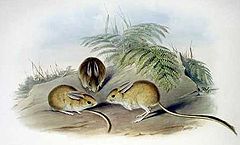- Hopping mouse
-
Hopping mice
Temporal range: Pleistocene - Recent
Notomys cervinus Scientific classification Kingdom: Animalia Phylum: Chordata Subphylum: Vertebrata Class: Mammalia Subclass: Eutheria Order: Rodentia Superfamily: Muroidea Family: Muridae Subfamily: Murinae Genus: Notomys
Lesson, 1842Species - N. alexis
- †N. amplus
- N. aquillo
- N. cervinus
- N. fuscus
- †N. longicaudatus
- †N. macrotis
- N. mitchelli
- †N. mordax
- †N. robustus
A hopping mouse is any of about ten different Australian native mice in the genus Notomys. They are rodents, not marsupials, and their ancestors are thought to have arrived from Asia about 5 million years ago.
All are brown or fawn, fading to pale grey or white underneath, have very long tails and, as the common name implies, well-developed hind legs. Half of the hopping mouse species have become extinct since European colonisation. The primary cause is probably predation from introduced foxes or cats, coupled with competition for food from introduced rabbits and cattle. The hopping mouse's primary diet is seeds. Australian hopping mouse can concentrate urine to as high as 10,000 mOsm/L. This allows the mouse to survive in the desert without drinking water.
- Spinifex Hopping Mouse (Notomys alexis)
- The extinct Short-tailed Hopping Mouse (Notomys amplus) was the largest species at around 100 g.
- Northern Hopping Mouse (Notomys aquilo)
- The Fawn Hopping Mouse (Notomys cervinus) is found on the sparsely vegetated arid gibber plains and claypans of the Lake Eyre Basin. Small at around 30 to 50 g, and light in colour, it is gregarious and feeds at night on seeds, insects, and green shoots, not needing to drink water. It is classed as vulnerable.
- Some small Dusky Hopping Mouse (Notomys fuscus) populations retain a slender hold on existence in the Strzelecki Desert. They feed, mostly on seeds, at night and shelter in deep vertical burrows.
- The Long-tailed Hopping Mouse (Notomys longicaudatus)is an extinct species, which was widespread in the drier regions of southern and central Australia. It dug burrows in stiff, clay soils. It liked raisins, but was not a pest to the stores of settlers. Only a handful of specimens were collected and the last record dates from 1901, although skull fragments were found in an owl pellet in 1977.
- Big-eared Hopping Mouse (Notomys macrotis)
- Mitchell's Hopping Mouse (Notomys mitchellii)
- The Darling Downs Hopping Mouse (Notomys mordax) is almost certainly extinct and is known only from a single skull collected somewhere on the Darling Downs of south-east Queensland in the 1840s, apparently from a creature similar to Mitchell's Hopping-mouse. The introduction of cattle to the Darling Downs has greatly changed the ecology of the region, and seen several other species exterminated or seriously threatened. (See Paradise Parrot and Yaminon.)
- The Great Hopping Mouse (Notomys robustus Mahoney, Smith and Medlin 2008) is extinct. It is known only from skulls found in owl pellets in the Flinders Ranges. Some pellets also include bones of the introduced House Mouse—indicating that it survived into historic times, possibly the second half of the 19th century. From the skull, it appears to have been relatively large (perhaps the size of N. amplus or a little more) and to have escaped collection by early 19th century naturalists by chance. From the location of the deposits it is assumed that it preferred clay rather than sandy soils. It is notable that very few of the clay-living hopping mice have survived European settlement, sand dunes apparently providing a more secure refuge from competitors and predators. Also commonly known as the Broad-cheeked Hopping-mouse.
References
- "Hopping mouse - bird". 2008. http://swifft.net.au/bird/index.php?title=Hopping_mouse. Retrieved 2008-10-10.
- "Australian Terrestrial Biodiversity Assesement 2002 - 6. Mammals". 2002. http://www.anra.gov.au/topics/vegetation/pubs/biodiversity/bio_assess_mammals.html. Retrieved 2008-10-10.
- IUCN (2008). "IUCN Red List - Search Results (for 'hopping mouse')". Archived from the original on 2008-06-27. http://web.archive.org/web/20080627171222/http://www.iucnredlist.org/search. Retrieved 2008-10-10.
